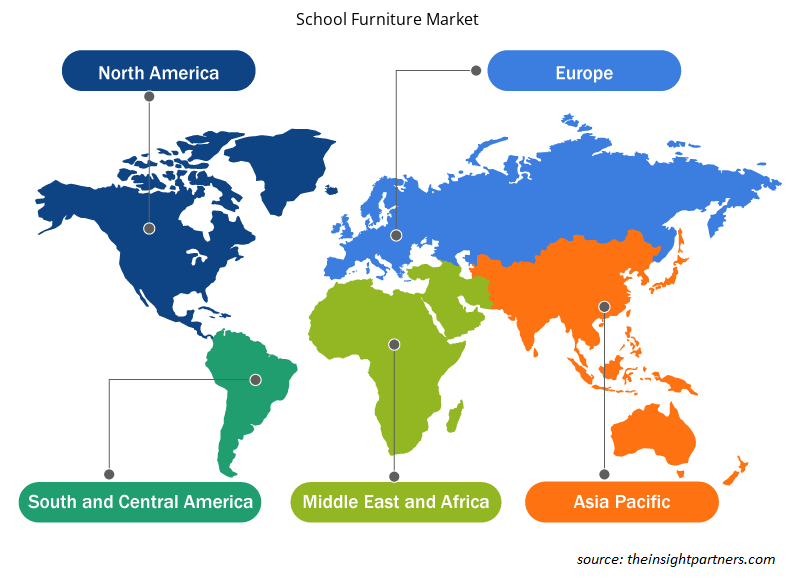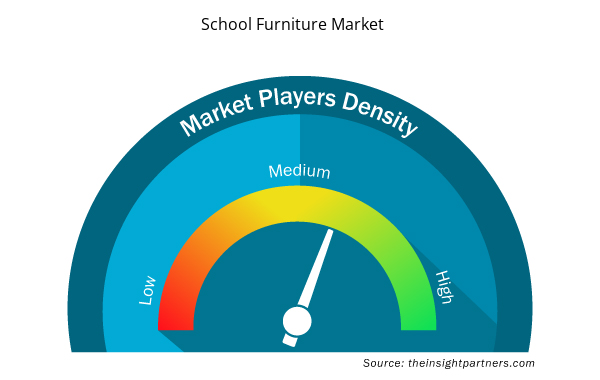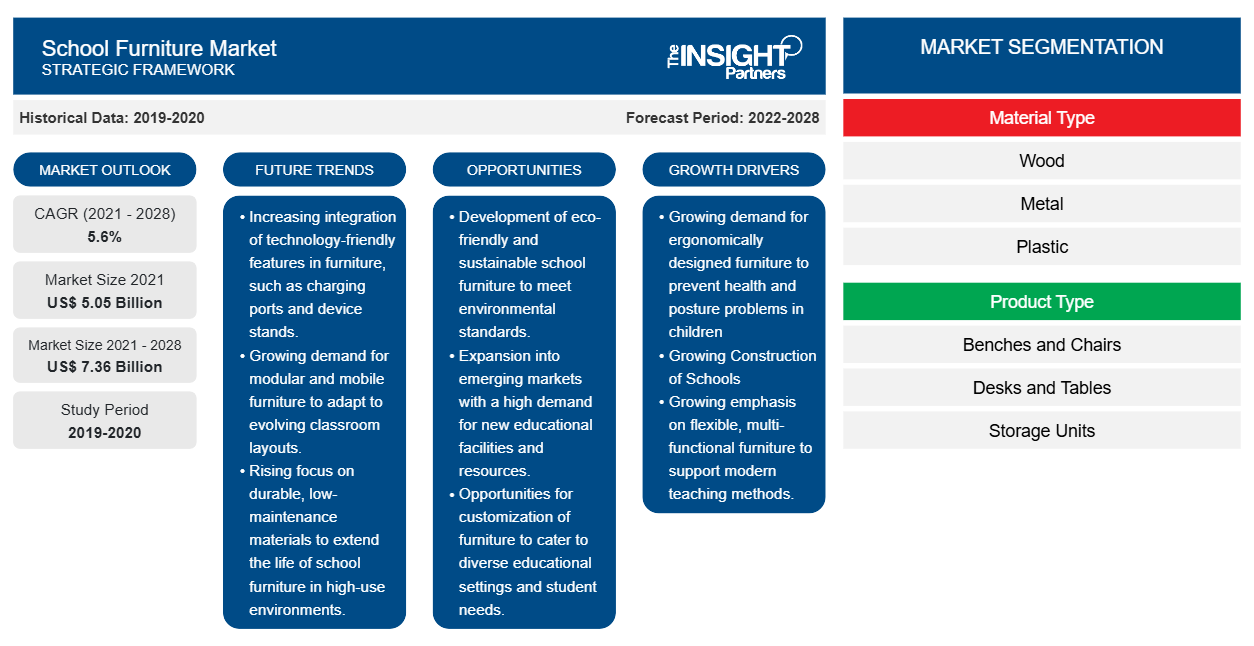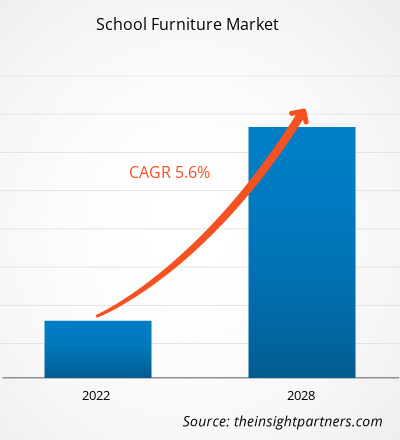[Forschungsbericht] Der weltweite Markt für Schulmöbel wurde im Jahr 2021 auf 5.047,95 Millionen US-Dollar geschätzt; von 2022 bis 2028 wird ein durchschnittliches jährliches Wachstum von 5,6 % erwartet.
Schulmöbel wie Bücherregale, Schließfächer, Schränke, Schautafeln, Schreibtische, Stühle, Akten- und Lagerschränke sowie Laborgeräte werden aus robusten, benutzerfreundlichen und hochwertigen Materialien wie Holz, Metall, mitteldichten Faserplatten (MDF) und Kunststoffen hergestellt. Schulmöbel sind so konzipiert, dass sie sowohl das körperliche als auch das geistige Wohlbefinden gewährleisten, sodass sich die Schüler voll und ganz auf ihr Studium konzentrieren können. Sie tragen auch dazu bei, die Flexibilität und Gesamtproduktivität von Lehrern und Schülern zu verbessern und verwandeln den physischen Raum in eine dynamische Lernumgebung.
Die wachsende Nachfrage nach ergonomisch gestalteten Möbeln zur Vorbeugung von Gesundheits- und Haltungsproblemen bei Kindern ist der wichtigste Markttreiber. Die Schaffung von Lernumgebungen, in denen sich die Schüler konzentrieren und wohlfühlen, ist zu einem der Hauptziele von Pädagogen geworden und beeinflusst damit den globalen Schulmöbelmarkt positiv . Im neuen Zeitalter umfassender, interaktiver und dynamischer Unterrichtsstile wie Blended Learning und Flip Classrooms sind tragbare und anpassbare Möbel mit einfacher Umgestaltung erforderlich geworden.
Passen Sie diesen Bericht Ihren Anforderungen an
Sie erhalten kostenlose Anpassungen an jedem Bericht, einschließlich Teilen dieses Berichts oder einer Analyse auf Länderebene, eines Excel-Datenpakets sowie tolle Angebote und Rabatte für Start-ups und Universitäten.
- Holen Sie sich die wichtigsten Markttrends aus diesem Bericht.Dieses KOSTENLOSE Beispiel umfasst eine Datenanalyse von Markttrends bis hin zu Schätzungen und Prognosen.
Darüber hinaus werden verschiedene Rohstoffe für die Möbelproduktion eingeführt, und diese besonderen Materialien haben sich als nachhaltiger, langlebiger und stabiler als herkömmliche Materialien erwiesen, was dem Marktwachstum Auftrieb verleiht. Die Hersteller verwenden Materialien wie verarbeitetes oder technisches Holz, geformten Kunststoff und Hochdrucklaminat, um Bänke, Stühle und Tische für Klassenzimmer und Schulen herzustellen. Möbel mit zusätzlichen Aufbewahrungsmöglichkeiten dienen als platzsparende Taktik in kleineren, kompakten Klassenzimmern, und die Nachfrage danach hat in den letzten Jahren deutlich zugenommen. Beispielsweise produziert CBT Supply Dba Smartdesks intelligente Tische und Stühle mit Stapelbarkeit und multifunktionalen Anwendungen für Klassenzimmer und Büros. Daher wird die steigende Nachfrage nach flexiblen Möbeln das Marktwachstum im Prognosezeitraum ankurbeln.
Markteinblicke
Zunehmender Schulbau
Aufgrund des schnellen Bevölkerungswachstums wird weltweit mit einem Anstieg des Schulbaus gerechnet. Der zunehmende Fokus auf den Bildungssektor in städtischen und ländlichen Gebieten sowie die von Regierungen weltweit eingeführten obligatorischen Grundschulprogramme treiben den Anstieg des Schulbaus voran. Laut dem Center on Budget and Policy Priorities wurden im Jahr 2018 in Nordamerika rund 98,9 Milliarden US-Dollar für Bildungsinfrastrukturprojekte ausgegeben, was einem Ausgabenanstieg von fast 10 % seit 2017 entspricht. Angesichts der zunehmenden Schuleinrichtungen, überfüllter Klassenzimmer, geänderter Bausicherheitsvorschriften und des weltweiten technischen Fortschritts stehen die Beamten vor dem Dilemma, entweder in neue Infrastruktur zu investieren oder die bestehende zu modernisieren. Regierungen und Gesellschaften auf der ganzen Welt sind bestrebt, ihre Bildungssysteme weiterzuentwickeln und sicherzustellen, dass alle Schüler die Möglichkeit haben, zur Schule zu gehen und die Fähigkeiten und Kenntnisse zu erwerben, die sie für ein produktives und gesundes Leben benötigen. Um die Bildungsqualität zu verbessern, sollte die Bildungsinfrastruktur modernisiert werden.
Darüber hinaus hat die weltweit steigende Zahl der Schüler die Nachfrage nach Tischen und Stühlen für Klassenzimmer erhöht, da diese für den Schulbetrieb erforderlich sind. Die zunehmende Verwendung unkonventioneller Rohstoffe für Klassenzimmermöbel führt zu Renovierungen, Kooperationen und ergonomischen Möbeln für Klassenzimmer. Mehrere Schulen ersetzen nach und nach traditionelle Schulmöbel durch ästhetisch ansprechende Infrastruktur, um die Unterrichtsumgebung angenehm zu gestalten. Die Einführung von Drehstühlen mit ergonomischen Eigenschaften ist in vielen Schulen eine Neuerung.
Einblicke in Materialtypen
Basierend auf der Materialart ist der Markt für Schulmöbel in Holz, Metall, Kunststoff und andere unterteilt. Im Jahr 2021 dominierte das Holzsegment den Markt für Schulmöbel.
Fleetwood Furniture; Herman Miller, Inc; KI; Steelcase Inc.; Virco, Inc.; Scholar Craft; Global Furniture Group; Educan; Ven-Rez; und Mitybilt gehören zu den wichtigsten Akteuren auf dem Markt für Schulmöbel. Führende Akteure verfolgen verschiedene Strategien, wie Fusionen und Übernahmen sowie Produkteinführungen, um ihre geografische Präsenz und Kundenbasis zu erweitern.
Bericht-Spotlights
- Fortschrittliche Trends in der Schulmöbelbranche helfen den Akteuren bei der Entwicklung wirksamer langfristiger Strategien
- Von Unternehmen verfolgte Geschäftswachstumsstrategien zur Sicherung des Wachstums in entwickelten und sich entwickelnden Märkten
- Quantitative Analyse des Schulmöbelmarktes von 2021 bis 2028
- Schätzung der Nachfrage nach Schulmöbeln in verschiedenen Branchen
- PEST-Analyse zur Analyse der politischen, wirtschaftlichen, soziokulturellen und technologischen Veränderungen im Geschäftsumfeld
- Aktuelle Entwicklungen zum Verständnis der Wettbewerbssituation auf dem Markt und der Nachfrage nach Schulmöbeln
- Markttrends und -aussichten gepaart mit Faktoren, die das Wachstum des Schulmöbelmarktes vorantreiben und bremsen
- Strategien, die das kommerzielle Interesse im Hinblick auf das Wachstum des Schulmöbelmarktes untermauern und den Entscheidungsprozess unterstützen
- Die Größe des Schulmöbelmarktes an verschiedenen Marktknoten
- Detaillierte Übersicht und Segmentierung des Schulmöbelmarktes sowie seiner Branchendynamik
Die „Schulmöbelmarktprognose bis 2028“ ist eine spezialisierte und eingehende Studie der Chemie- und Materialindustrie, die sich auf die Trendanalyse des Schulmöbelmarkts konzentriert. Der Bericht soll einen Überblick über den Markt mit detaillierter Marktsegmentierung geben. Der Schulmöbelmarkt wird auf der Grundlage von Materialtyp, Produkttyp und Vertriebskanal kategorisiert. Basierend auf dem Materialtyp wird der Markt in Holz, Metall, Kunststoff und andere segmentiert. Basierend auf dem Produkttyp wird der Markt in Wohn- und Gewerbe- und Industriebereich unterteilt. In Bezug auf den Vertriebskanal wird der Markt in Fachgeschäfte, Online-Einzelhandel und Verträge/Ausschreibungen unterteilt.
Regionale Einblicke in den Schulmöbelmarkt
Die regionalen Trends und Faktoren, die den Schulmöbelmarkt im Prognosezeitraum beeinflussen, wurden von den Analysten von Insight Partners ausführlich erläutert. In diesem Abschnitt werden auch die Marktsegmente und die Geografie des Schulmöbelmarkts in Nordamerika, Europa, im asiatisch-pazifischen Raum, im Nahen Osten und Afrika sowie in Süd- und Mittelamerika erörtert.

- Erhalten Sie regionale Daten zum Schulmöbelmarkt
Umfang des Marktberichts für Schulmöbel
| Berichtsattribut | Details |
|---|---|
| Marktgröße im Jahr 2021 | 5,05 Milliarden US-Dollar |
| Marktgröße bis 2028 | 7,36 Milliarden US-Dollar |
| Globale CAGR (2021 - 2028) | 5,6 % |
| Historische Daten | 2019-2020 |
| Prognosezeitraum | 2022–2028 |
| Abgedeckte Segmente | Nach Materialtyp
|
| Abgedeckte Regionen und Länder | Nordamerika
|
| Marktführer und wichtige Unternehmensprofile |
|
Marktdichte von Schulmöbeln: Auswirkungen auf die Geschäftsdynamik verstehen
Der Markt für Schulmöbel wächst rasant, angetrieben durch die steigende Nachfrage der Endverbraucher aufgrund von Faktoren wie sich entwickelnden Verbraucherpräferenzen, technologischen Fortschritten und einem größeren Bewusstsein für die Vorteile des Produkts. Mit steigender Nachfrage erweitern Unternehmen ihr Angebot, entwickeln Innovationen, um die Bedürfnisse der Verbraucher zu erfüllen, und nutzen neue Trends, was das Marktwachstum weiter ankurbelt.
Die Marktteilnehmerdichte bezieht sich auf die Verteilung von Firmen oder Unternehmen, die in einem bestimmten Markt oder einer bestimmten Branche tätig sind. Sie gibt an, wie viele Wettbewerber (Marktteilnehmer) in einem bestimmten Marktraum im Verhältnis zu seiner Größe oder seinem gesamten Marktwert präsent sind.
Die wichtigsten auf dem Schulmöbelmarkt tätigen Unternehmen sind:
- Fleetwood-Möbel
- Herman Miller, Inc.
- KI
- Steelcase Inc.
- Virco, Inc.
Haftungsausschluss : Die oben aufgeführten Unternehmen sind nicht in einer bestimmten Reihenfolge aufgeführt.

- Überblick über die wichtigsten Akteure auf dem Schulmöbelmarkt
Firmenprofile
- Fleetwood-Möbel
- Herman Miller, Inc
- KI
- Steelcase Inc.
- Virco, Inc.
- Gelehrtes Handwerk
- Globale Möbelgruppe
- Bildungswesen
- Ven-Rez
- Mitybilt
- Historische Analyse (2 Jahre), Basisjahr, Prognose (7 Jahre) mit CAGR
- PEST- und SWOT-Analyse
- Marktgröße Wert/Volumen – Global, Regional, Land
- Branche und Wettbewerbsumfeld
- Excel-Datensatz



Report Coverage
Revenue forecast, Company Analysis, Industry landscape, Growth factors, and Trends

Segment Covered
This text is related
to segments covered.

Regional Scope
North America, Europe, Asia Pacific, Middle East & Africa, South & Central America

Country Scope
This text is related
to country scope.
Häufig gestellte Fragen
The major players operating in the global school furniture market are Fleetwood Furniture; Herman Miller, Inc; KI; Steelcase Inc.; Virco, Inc.; Scholar Craft; Global Furniture Group; Educan; Ven-Rez; and Mitybilt.
In 2021, North America held the largest share of the global school furniture market. The rise in the educational infrastructure would cater the demand of school furniture in the region. The region is also flourishing owing to presence of manufacturing facilities.
The wood segment held the largest market share. Wooden furniture is the most popular in schools, owing to the high manufacturing output of wooden products in comparison to other materials. Moreover, wood is conventionally looked at as the most preferred material for furniture production.
The benches and chairs segment held the largest market share. School chairs vary in design and are primarily made of wood, metal, and synthetic plastic materials. Folding chairs, rocking chairs, loungers, and many others are quite popular among customers.
Asia Pacific is estimated to register the fastest CAGR in the global school furniture market over the forecast period. Many Asia Pacific countries, such as China and India, are the world's fastest-growing populations. With a growing population construction and school furniture material are growing rapidly in Asia Pacific.
The contracts/bids segment held the largest share of the market in 2021. Most of the schools organize bids for school furniture. The companies can be given a contract for vendor ship, replacement, or repair based on the contract signed between the schools and them.
Trends and growth analysis reports related to Consumer Goods : READ MORE..
The List of Companies - School Furniture Market
- Fleetwood Furniture
- Herman Miller, Inc.
- KI
- Steelcase Inc.
- Virco, Inc.
- Scholar Craft
- Global Furniture Group
- Educan
- Ven-Rez
- Mitybilt
The Insight Partners performs research in 4 major stages: Data Collection & Secondary Research, Primary Research, Data Analysis and Data Triangulation & Final Review.
- Data Collection and Secondary Research:
As a market research and consulting firm operating from a decade, we have published and advised several client across the globe. First step for any study will start with an assessment of currently available data and insights from existing reports. Further, historical and current market information is collected from Investor Presentations, Annual Reports, SEC Filings, etc., and other information related to company’s performance and market positioning are gathered from Paid Databases (Factiva, Hoovers, and Reuters) and various other publications available in public domain.
Several associations trade associates, technical forums, institutes, societies and organization are accessed to gain technical as well as market related insights through their publications such as research papers, blogs and press releases related to the studies are referred to get cues about the market. Further, white papers, journals, magazines, and other news articles published in last 3 years are scrutinized and analyzed to understand the current market trends.
- Primary Research:
The primarily interview analysis comprise of data obtained from industry participants interview and answers to survey questions gathered by in-house primary team.
For primary research, interviews are conducted with industry experts/CEOs/Marketing Managers/VPs/Subject Matter Experts from both demand and supply side to get a 360-degree view of the market. The primary team conducts several interviews based on the complexity of the markets to understand the various market trends and dynamics which makes research more credible and precise.
A typical research interview fulfils the following functions:
- Provides first-hand information on the market size, market trends, growth trends, competitive landscape, and outlook
- Validates and strengthens in-house secondary research findings
- Develops the analysis team’s expertise and market understanding
Primary research involves email interactions and telephone interviews for each market, category, segment, and sub-segment across geographies. The participants who typically take part in such a process include, but are not limited to:
- Industry participants: VPs, business development managers, market intelligence managers and national sales managers
- Outside experts: Valuation experts, research analysts and key opinion leaders specializing in the electronics and semiconductor industry.
Below is the breakup of our primary respondents by company, designation, and region:

Once we receive the confirmation from primary research sources or primary respondents, we finalize the base year market estimation and forecast the data as per the macroeconomic and microeconomic factors assessed during data collection.
- Data Analysis:
Once data is validated through both secondary as well as primary respondents, we finalize the market estimations by hypothesis formulation and factor analysis at regional and country level.
- Macro-Economic Factor Analysis:
We analyse macroeconomic indicators such the gross domestic product (GDP), increase in the demand for goods and services across industries, technological advancement, regional economic growth, governmental policies, the influence of COVID-19, PEST analysis, and other aspects. This analysis aids in setting benchmarks for various nations/regions and approximating market splits. Additionally, the general trend of the aforementioned components aid in determining the market's development possibilities.
- Country Level Data:
Various factors that are especially aligned to the country are taken into account to determine the market size for a certain area and country, including the presence of vendors, such as headquarters and offices, the country's GDP, demand patterns, and industry growth. To comprehend the market dynamics for the nation, a number of growth variables, inhibitors, application areas, and current market trends are researched. The aforementioned elements aid in determining the country's overall market's growth potential.
- Company Profile:
The “Table of Contents” is formulated by listing and analyzing more than 25 - 30 companies operating in the market ecosystem across geographies. However, we profile only 10 companies as a standard practice in our syndicate reports. These 10 companies comprise leading, emerging, and regional players. Nonetheless, our analysis is not restricted to the 10 listed companies, we also analyze other companies present in the market to develop a holistic view and understand the prevailing trends. The “Company Profiles” section in the report covers key facts, business description, products & services, financial information, SWOT analysis, and key developments. The financial information presented is extracted from the annual reports and official documents of the publicly listed companies. Upon collecting the information for the sections of respective companies, we verify them via various primary sources and then compile the data in respective company profiles. The company level information helps us in deriving the base number as well as in forecasting the market size.
- Developing Base Number:
Aggregation of sales statistics (2020-2022) and macro-economic factor, and other secondary and primary research insights are utilized to arrive at base number and related market shares for 2022. The data gaps are identified in this step and relevant market data is analyzed, collected from paid primary interviews or databases. On finalizing the base year market size, forecasts are developed on the basis of macro-economic, industry and market growth factors and company level analysis.
- Data Triangulation and Final Review:
The market findings and base year market size calculations are validated from supply as well as demand side. Demand side validations are based on macro-economic factor analysis and benchmarks for respective regions and countries. In case of supply side validations, revenues of major companies are estimated (in case not available) based on industry benchmark, approximate number of employees, product portfolio, and primary interviews revenues are gathered. Further revenue from target product/service segment is assessed to avoid overshooting of market statistics. In case of heavy deviations between supply and demand side values, all thes steps are repeated to achieve synchronization.
We follow an iterative model, wherein we share our research findings with Subject Matter Experts (SME’s) and Key Opinion Leaders (KOLs) until consensus view of the market is not formulated – this model negates any drastic deviation in the opinions of experts. Only validated and universally acceptable research findings are quoted in our reports.
We have important check points that we use to validate our research findings – which we call – data triangulation, where we validate the information, we generate from secondary sources with primary interviews and then we re-validate with our internal data bases and Subject matter experts. This comprehensive model enables us to deliver high quality, reliable data in shortest possible time.


 Holen Sie sich ein kostenloses Muster für diesen Bericht
Holen Sie sich ein kostenloses Muster für diesen Bericht